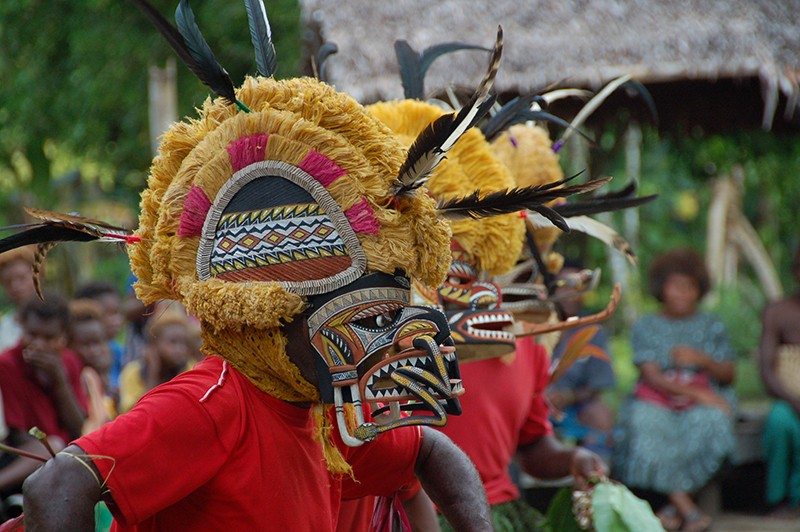 |
Men wearing tatanua masks at a sing-sing in Libba Village, New Ireland, New Ireland Province, Papua New Guinea.
Taken during the Roski-Keller-Martin Expedition to the New Ireland Province in 2008. |
Acceptance
When we think of masks in western culture, we most often think of tools used to disguise one’s identity. In most other cultures in the world, however, masks are actor-powered facsimiles of gods, spirits, ancestors and animals. In the malagan carving tradition of Papua New Guinea’s New Ireland Province, hundreds of different masks represent various aspects of the province’s life cycle. The colorful tatanua masks featured in this post come at the end of this cycle—mostly danced in mortuary feasts. In this post we examine the usage of these masks looking at their creation, name, usage, and finally looking at what happens to these masks after they have been danced.
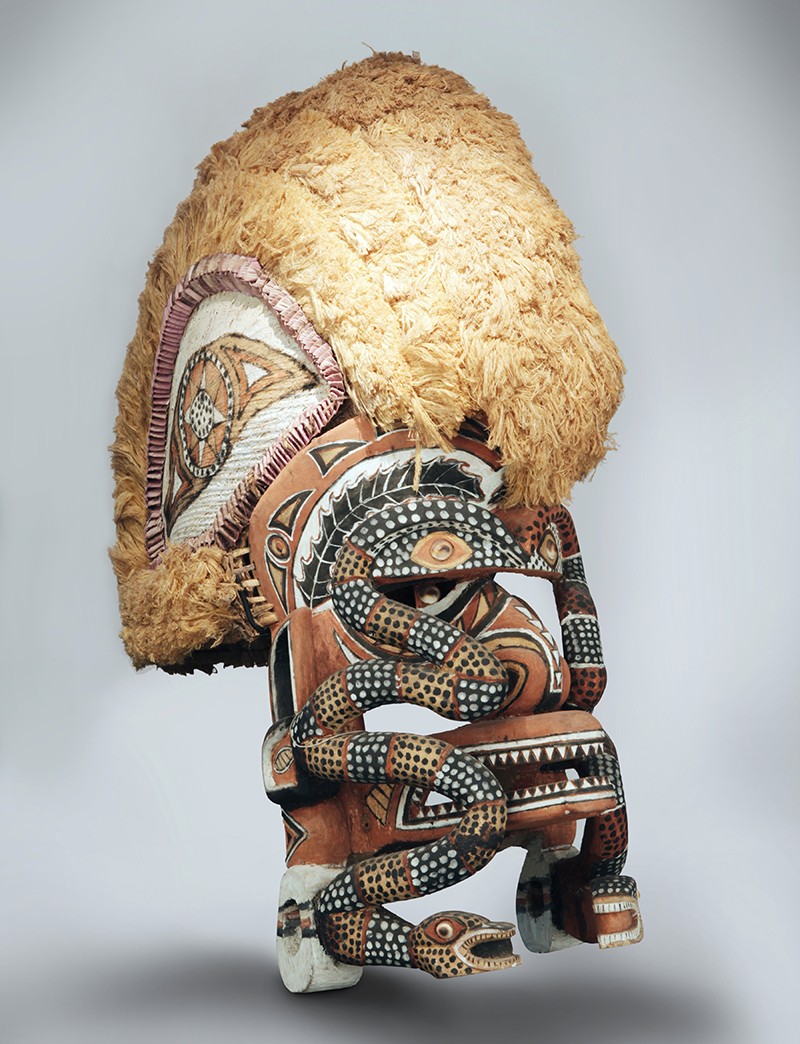 |
Mask (Tatanua), 20th century
Libba Village, New Ireland, New Ireland Province, Papua New Guinea, Melanesia
Wood, paint, cane, fiber and operculum; 29 1/2 x 26 3/4 x 10 1/2 in.
L.2010.4.7
Loan courtesy of Gayle and Edward P. Roski |
Malagan Materials
Likely due to their iconic form, light weight and manageable size, tatanua are by far the best represented malagan carvings in museum collections. The masks can immediately be characterized by several distinct features, particularly their arching coiffure. The crest on these masks is made from either an orange or reddish-brown fiber and roughly mimics a hairstyle worn by men in mourning. The wood often comes from lime trees and is lightweight enough that it is ideal for dance masks. Sea snail shells are exclusively used for the eyes of these masks and sometimes as ornaments decorating the remainder of the mask. The panels visible on both sides of the crest are ochre-dyed bark cloth, but this element can vary depending on the subtype of tatanua. Instead of bark cloth panels some older variants have feathers, wool, shells, sticks, or seeds forming distinct color bands; tatanua made today may instead use western cloth and dyes.
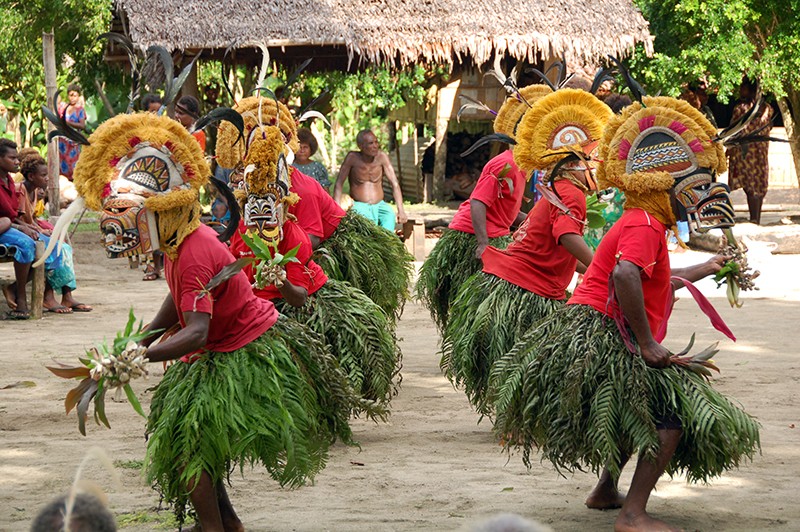 |
Men wearing tatanua masks at a sing-sing in Libba Village, New Hanover Island, New Ireland Province, Papua New Guinea.
Taken during the Roski-Keller-Martin Expedition to the New Ireland Province in 2008. |
In a Word
Accounts regarding the antecedent for the name tatanua have changed over time. The earliest ones suggest that the name is synonymous with the word spirit. This is further reinforced by the alternate usage of the term miteno among the New Ireland groups that refer to spirits as miteno instead of tatanua. Indeed, spirits do play important parts of malagan ceremonies. The word malagan itself roughly translates to likeness, with different spirits and ancestors being the most common identities assumed by malagan carvings. Despite the belief by early ethnographers that tatanua held spirits or souls of the deceased, recent interviews now indicate that the tatanua were instead intended to appear to be the idealized forms of man, representing all of the handsome qualities of a youthful man. This new theory certainly lends to the mask’s oldest recorded usage in funerary dances.
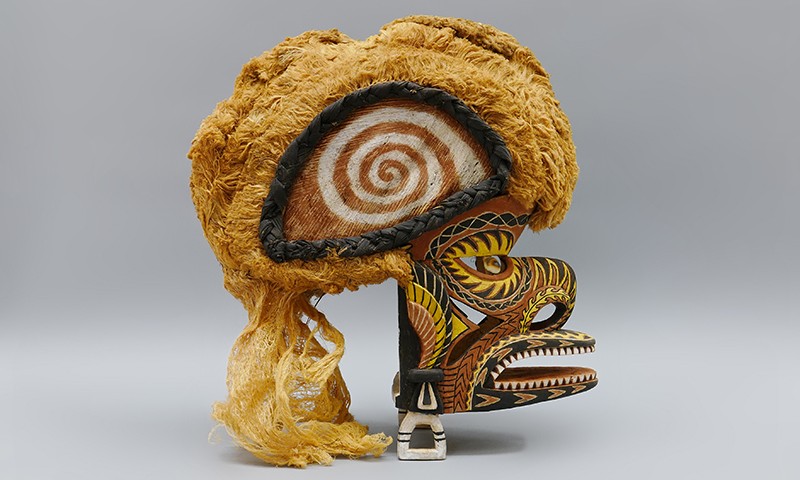 |
Mask (Tatanua), 20th century
New Ireland Province, Papua New Guinea, Melanesia
Wood, pigment, cane, fiber and shell
2018.13.27
Gift of Anne Shih and Long Shung |
Function over Form
When presented with motifs, the most common response by academics and scholars is to ask the question, “what do these symbols represent?” The tatanua presented in this post, for example, have a few symbols and forms which immediately draw the eye: namely eyes. Both the spiral in white and orange and the lens decorating both sides of two of the tatanua are eyes. This question though is not nearly as fruitful as asking how these forms inform the usage of the masks. A little over 400 malagan designs have been recorded, but it is estimated that there are thousands of unrecorded carving types. Malagan art in general is all funerary art, as it is used in mortuary feasts which can last up to a year after the passing of a family member. The dances have been described differently by different ethnographers, likely attributable to the vast region in which malagan carving tradition is now practiced. The earliest description comes from Richard Parkinson, an ethnographer who published his book including his travels to New Ireland in 1907. He described the dance as an erotic dance in which four men attempted to court a woman, with only the final contender achieving any degree of success. Other ethnographers have described different male-only dances, and in the past few decades tatanua have been used in new non-funerary dances.
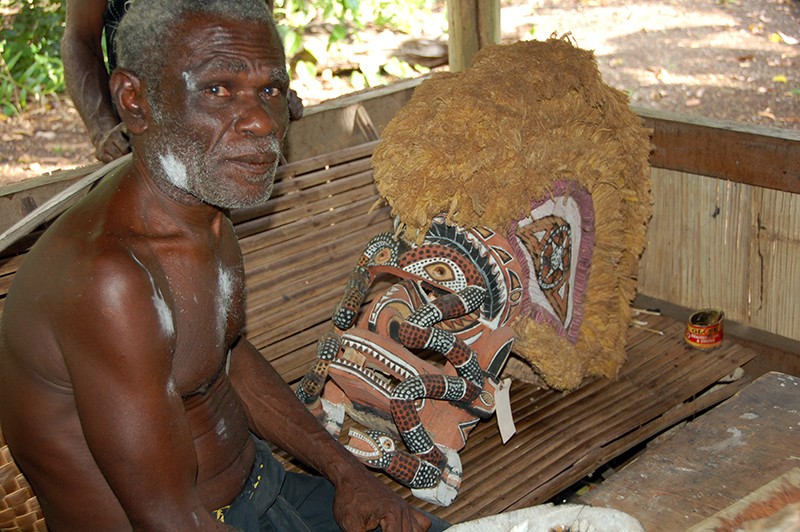 |
Photograph of a Papuan man sitting by what would become L.2010.4.7, Libba Village, New Ireland, New Ireland Province, Papua New Guinea.
Taken during the Roski-Keller-Martin Expedition to the New Ireland Province in 2008. |
Recycled Art
Despite a significant commitment of time and effort, many malagan carvings lose the power their carvers imbue in them after being seen for the first time. Some items, particularly tatanua, can be reused on multiple occasions before they are considered powerless, but their relatively brief half-life has served both the native inhabitants of New Ireland and travelling ethnographers and collectors alike. Objects that would have previously been discarded to allow them to decay are now often sold off when the opportunity is presented, another reason why tatanua are so prevalent in museums.
Text and images may be under copyright. Please contact Collection Department for permission to use. References are available on request. Information subject to change upon further research.






Comments 1
correction: Liba village is not on New Hanover island but rather on the mainland in Central New Ireland along the Boluminski Highway.